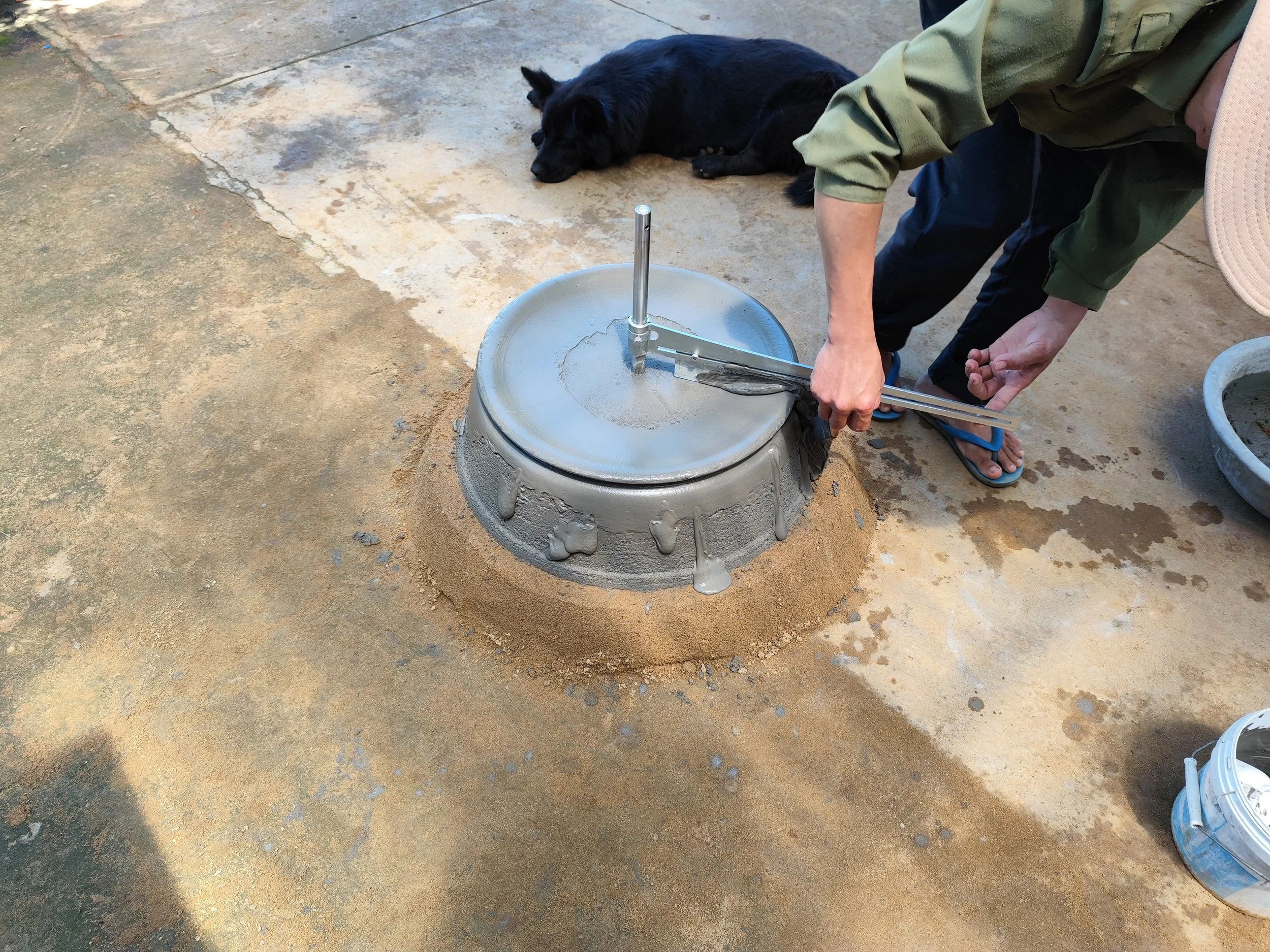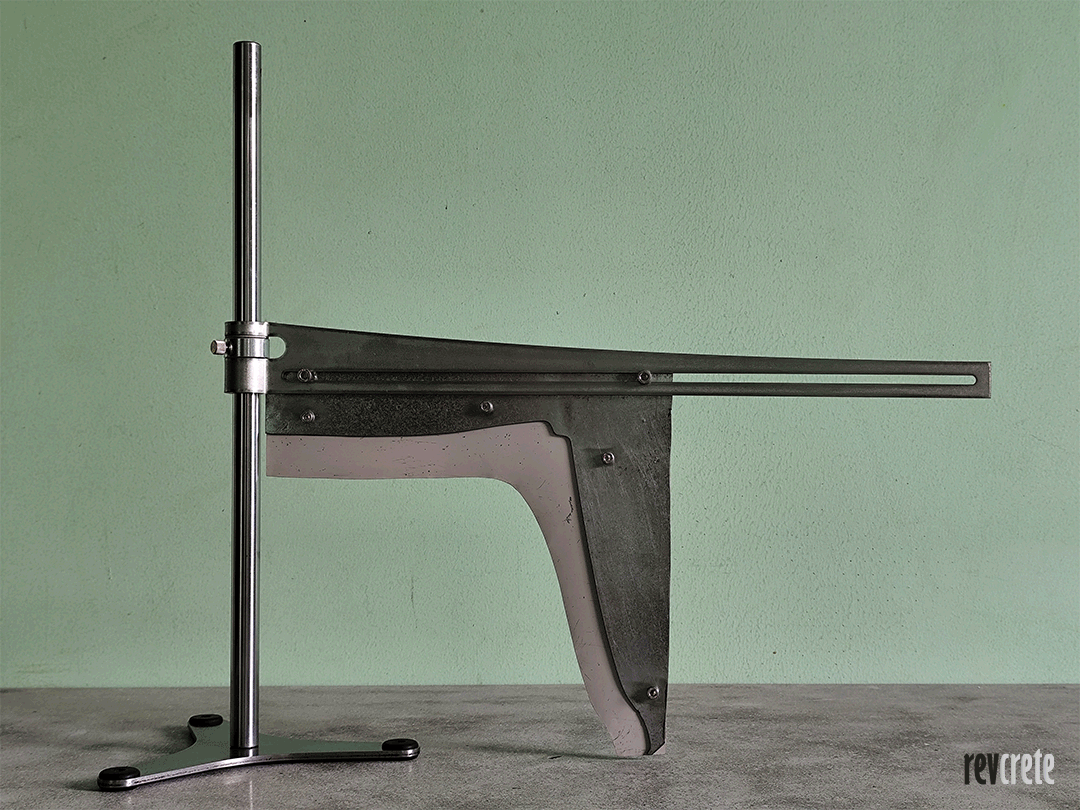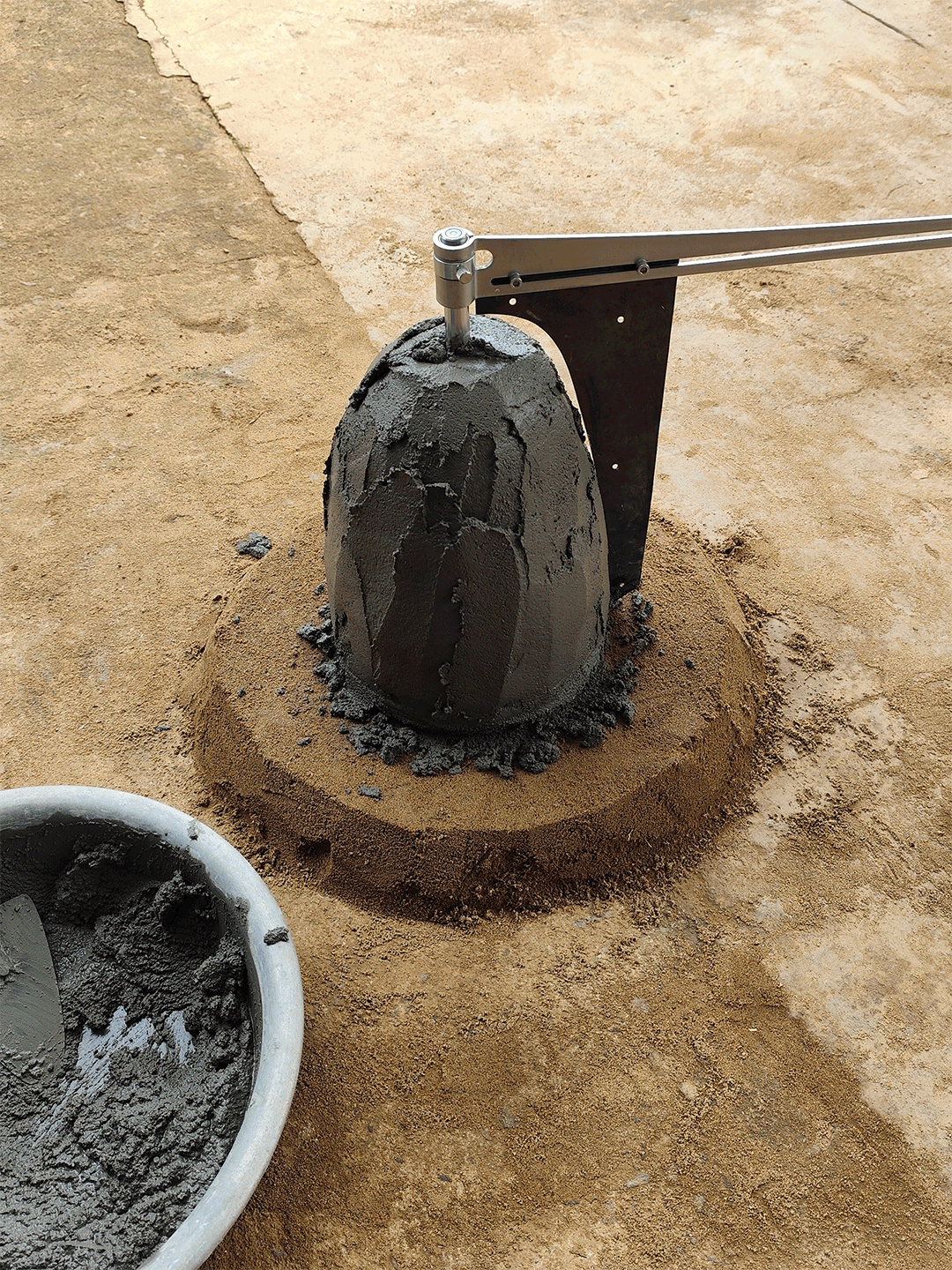Typical mid-size concrete artworks, endless achievements with the dedicated toolkit on hand.
The project is about concrete creation, not any specific pieces, but the way it was formed. Before we dive into the technique called "revolving", let's enjoy some typical results first...
If you already have experience with concrete countertop making, then polishing a washbowl could be a soft conversion that still uses your available equipment. While a fire bowl must be made in conjunction with appropriate materials for the mixture and reinforced elements, or it will break when fired*. Or the bowl could be used for planting any botanical species.
(*) Additional information could be found in the Creative Handbook.Bowls (1) and (2) are painted in aubergine on top of an exposed aggregate concrete bench.
Ficus bonsai tree in a painted dark brown bowl (1).
Our creation of decorative, long-lasting concrete pots/planters stands out as a unique collection, with various styles, colors, sizes, and finishes to choose from; those are able to fulfill almost all kinds of demands for any bonsai practitioner cultivating some species of bonsai trees or just for householders planting some evergreen trees.
Particularly for pots/planters, its template could be radially extended (or shrunk) for size variation, in conjunction with different materials, colors, and edges as well, to get countless results.
Concrete pots (2) with size and color variation: [Top] White cement slurried pot with a metallic gold rim, hybrid sealed. [Middle & Bottom] Artist acrylic purple, hooker’s green painted and varnished on grey cement slurried pots.
Concrete pots/planters could be an ideal alternative for individuals who manage (or are willing to manage) a nursery, either bonsai or evergreen trees. Whereas trees take many years to become bonsai, especially for large yamadori (trees that are collected from nature). Self-made concrete will significantly lower your upfront investment in pots when compared with other materials, clay, for example, and especially when you demand a lot of medium- to large-size containers. It is one of the reasons we first anticipated this technique.
3-year-old pots (4): [Left] A used light brown D42cm pot. [Right] A Ficus benjamina pre-bonsai tree in a dark brown D35cm pot.
Tray
Suiseki display (or viewing stone) with an agate (shaped like a toad or tree frog) and a painted concrete tray layered with beige sand. The arrangement somehow could be imagined as “a frog on a lotus pad”, or maybe we should paint the tray green for easy perception.
Our design for the revolving technique is pedestal tables/stands consisting of two halves, both of which sit flush against each other, with a fall-off avoidance pin* inserted through their central hole.
This structure initially maintains a "workable"** object while allowing for design diversity; second, it joins these parts; third, it allows the top to be swiveled around occasionally; and lastly, it prevents the top from collapsing under the unintended disruption.
(*) Details about the pin and how to install it and (**) workability could be found in the Creative Handbook.Mushroom Table Set
Table (H60cm x D60cm) in titanium white, 2K overcoated; its base could be used as a stool (in grey cement, with additional cut-off sections) and as a planter (in white cement, sealed) for a bird's nest fern (Asplenium nidus).
The designs could be used as an occasional table, bedside table, stand, or whatever you like. While the larger ones properly fit your purpose as a tea/coffee or even dining table, various base and top profiles could be mixed and matched to have many results in between for the table, from simple to fussy variants.
Garden Ornaments
A pair of “Lady & Gentleman” concrete lanterns finished with grey cement slurry. Basically, they consist of 3 pieces* each; both share the same revolved body profile, in conjunction with different cap styles and additional cut-off sections. These areas could vary to get something in between.
Add sought after depth to architecture and landscapes with these personality-style concrete lanterns, which are perfect for standalone or bunched applications that will breathe life into any space.
(*) The base and body of the lantern still utilize a fall-off avoidance pin inserted; the cap features a step for proper alignment with the body.
The “Gentleman” concrete [floor] lamp H82cm is wired up with an electric kit for lightening your room or walkway.
That is not all… More designs, including small- and mid-size pots, multi-stage fountains, another personality-style and Yukimi-like lanterns, and different table profiles will also be available shortly.
Are you curious about how they got made? Let's walk through from the beginning to the end of the revolving process for a typical bonsai pot (2).
In short, firstly, the sand template revolves a sand core, then concrete mixes are built up over this core, and it is finally shaped by revolving the concrete template around. Let the concrete dry for days, take it out of the sand, and then you will have your revolved art piece in hand to taste.
Both structural and decorative cement could be used for the mixture in this technique.Armature making with welded wire mesh seems quite daunting. Don't worry; it is not always required. There are other methods of concrete reinforcement that might be used; further guidance could be found in the Creative Handbook.
Performing your artwork on a benchtop could significantly reduce aches and pains from prolonged hunching while squatting. Just one major disadvantage is the limitation in sizing, so it is only suitable for small items, one by one.
So, what concrete revolving exactly is?
At first, troweling in combination with sweeping like this...
The principle of the concrete revolving procedure is very similar to the “revolve” command in any 3D modeling software to create a “solid of revolution”, obtained by sweeping the profile (template) around an axis (post) at a predefined angle (or full revolution), but in a realistic, solidified version.
Thus, changing the profiled templates will produce different results, which is the key to exploiting the technique.
While sand plays a crucial role in the technique by acting as a sort of temporary formwork that can withstand fresh concrete weight and be reused, enabling the creation of a concrete piece that is hollow, shell-structured, or vessel-shaped.
And sometimes revolving is like this, with back-and-forth rotations.
Skillsets
Core Building — just like a sand sculpture
Troweling
Revolving
Slurrying [optional] — with an additional cement slurry coat and aiding with a brush for achieving an authentic stone surface that is smooth, dense, consistent, and fully formed even with very fine features.
Hand Sanding [optional] — with appropriate abrasive materials for a perfect piece.
Grouting [optional] — The sanded rim and inner surface of the pot/planter should be grouted using a plastic rib. This layer not only covers any voids, pinholes, divots, or crevices but also decreases the permeability and increases the effectiveness of the sealer when used.
To deploy the technique, we have developed the first-of-its-kind commercial toolkit with a high level of completion.
Your All-Round Kit
Whether you are a beginner or a professional maker, sculptor, potter, or handyman who is just keen on doing home improvements with concrete, you can rely on our products to give you impressive results every time.
Ease-of-use
In order to help you excel in revolving workmanship, the toolkit was designed to achieve stability, durability, both accuracy and repeatability.
The technique is all in the Creative Handbook, which is meticulously written and ensures that you will not miss any singular detail for a sound concrete artwork.
Creative Handbook Snippet
The concise and transparent handbook is presented in 102 facing-page A5 format with over 80 images and illustrations; it's probably readable on almost any smartphone screen without the need for zooming. This exclusive guideline is suitable for most users, even those who haven't known about how to mix concrete. Page by page flows through the technique and anything in between. The gallery of revolved concrete artworks and template design inspiration sources is displayed in the final section.
No matter what your imagination is, with the know-how technique, the All-Round Kit and templates on hand, it could be partially or fully taken shape.
Just need to source raw materials, seek a shade, prepare the mixture, and then your playground is almost everywhere; various shapes could be achieved with the technique, and it doesn't require costly workshop equipment as in other concreting procedures.
Our works, ranging from tiny to enormous, are not limited to "revolving"; we also make concrete artworks with the "free-hand" technique, besides other popular concreting methods.
Front yard on a sunny morning.
The toolkit and accompanying tools, 32 template sets divided into 07 categories (disc, bowl, planter, pot and large pot, table/stand, and lantern), were previously available for pre-order on Kickstarter.
Ready-to-go tool set that consists of the All-Round Kit and 06 essential tools.
The set is ready to be sent out in a box with shipping labels affixed.
For news, updates, and teasers, follow us on









![A pair of planter (14) (H23cm x D57.5cm): [Left] one with crazing effect on the surface caused by “cement rich” slurry coat; [Right] another one is painted in dark grey with a glossy finish.](https://images.squarespace-cdn.com/content/v1/57088014c2ea5138c54e1134/1739358060150-L7X7FO1LG4YWHSZJSEV6/IMG_20240915_120811.jpg)






![“Magic hat” pots (1): [Closer] Buddhist pine bonsai in an original designed D50cm pot. [Further to the left] Bougainvillea tree blossoms in an extended D70cm pot.](https://images.squarespace-cdn.com/content/v1/57088014c2ea5138c54e1134/1739276952969-MA2E271XZ0OPJEV876ZT/IMG20240308073322+-+edited.jpg)














































































































